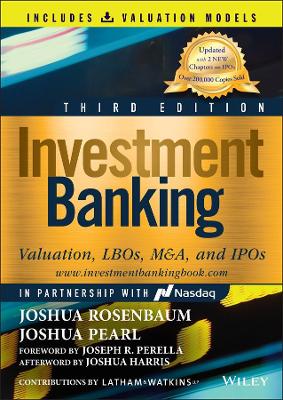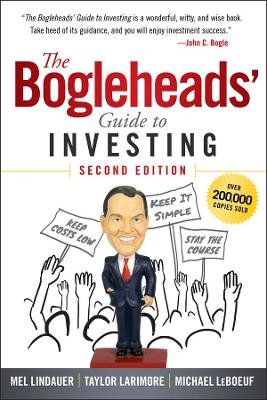Advanced Portfolio Management
 -15%
portes grátis
-15%
portes grátis
Advanced Portfolio Management
A Quant's Guide for Fundamental Investors
Paleologo, Giuseppe A.
John Wiley & Sons Inc
10/2021
208
Dura
Inglês
9781119789796
15 a 20 dias
486
1.1 What You Will Find Here 2
1.2 Asterisks; Or, How to Read This Book 3
1.3 Acknowledgments 3
Chapter 2 The Problem: From Ideas to Profit 5
2.1 How to Invest in Your Edge, and Hedge the Rest 7
2.2 How to Size Your Positions 8
2.3 How to Learn from Your History 8
2.4 How to Trade Efficiently 9
2.5 How to Limit Factor Risk 9
2.6 How to Control Maximum Losses 10
2.7 How to Determine Your Leverage 10
2.8 How to Analyze New Sources of Data 10
Chapter 3 A Tour of Risk and Performance 11
3.1 Introduction 12
3.2 Alpha and Beta 14
3.3 Where Does Alpha Come From? 15
3.4 Estimate Risk in Advance 18
3.4.1 What Is Risk? 18
3.4.2 Measuring Risk and Performance 20
3.5 First Steps in Risk Decomposition 25
3.6 Simple Hedging 26
3.7 Separation of Concerns 28
3.8 Takeaway Messages 29
Chapter 4 An Introduction to Multi-Factor Models 30
4.1 From One Factor to Many 31
4.2 ?Frequently Asked Questions About Risk 35
4.3 ?The Machinery of Risk Models 40
4.4 Takeaway Messages 43
Chapter 5 Understand Factors 44
5.1 The Economic Environment 47
5.1.1 Country 47
5.1.2 Industries 48
5.1.3 Beta 50
5.1.4 Volatility 54
5.2 The Trading Environment 56
5.2.1 Short Interest 56
5.2.2 Active Manager Holdings (AMH) 58
5.2.3 Momentum 60
5.3 The Company: Valuation Factors 66
5.3.1 Value 66
5.4 Takeaway Messages 71
Chapter 6 Use Effective Heuristics for Alpha Sizing 72
6.1 Sharpe Ratio 74
6.2 Estimating Expected Returns 76
6.3 Risk-Based Sizing 79
6.4 ?Empirical Analysis of the Sizing Rules 81
6.5 From Ideas to Positions 88
6.6 Time-Series Risk-Based Portfolio Targeting 89
6.7 ?Frequently Asked Questions About Performance 95
6.8 Takeaway Messages 96
Chapter 7 Manage Factor Risk 98
7.1 Tactical Factor Risk Management 99
7.1.1 Optimize If You Must 104
7.2 Strategic Factor Risk Management 107
7.2.1 Setting an Upper Limit on Factor Risk 107
7.2.2 Setting a Limit on Market Exposure 111
7.2.3 Setting an Upper Limit on Single-Stock Holdings 113
7.2.4 Setting an Upper Limit on Single-Factor Exposures 116
7.3 Systematic Hedging and Portfolio Management 118
7.4 Takeaway Messages 121
Chapter 8 Understand Your Performance 123
8.1 Factor 124
8.1.1 Performance Attribution 124
8.2 Idiosyncratic 127
8.2.1 Selection, Sizing, Timing 128
8.2.2 The Relationship Between Performance and Diversification 136
8.3 Trade Events Efficiently 139
8.4 ?Use Alternative Data! 142
8.5 ?Frequently Asked Questions About Performance 146
8.6 Takeaway Messages 148
Chapter 9 Manage Your Losses 149
9.1 How Stop-Loss Works 150
9.2 Why a Stop-Loss Policy? 151
9.3 The Costs and Benefits of Stop-Loss 154
9.4 Takeaway Messages 158
Chapter 10 ?Set Your Leverage Ratio for a Sustainable Business 160
10.1 A Framework for Leverage Decisions 162
10.2 Takeaway Messages 166
Chapter 11 ??Appendix 168
11.1 Essential Risk Model Formulas 168
11.1.1 Factor Model 168
11.1.2 Factor-Mimicking Portfolios 169
11.1.3 Percentage Idio Variance 170
11.1.4 Betas 170
11.1.5 Marginal Contribution to Factor Risk 170
11.2 Diversification 171
11.3 Mean-Variance Formulations 172
11.3.1 Mean-Variance Portfolios 172
11.3.2 A Robust Mean-Variance Formulation 173
11.4 Proportional-Rule Formulations 174
11.5 Generating Custom Factors 175
11.5.1 Interpretation and Use 179
11.6 Optimization Formulations 179
11.6.1 Equal-Sized Portfolio with Constraints on Participation Rate 179
11.7 Tactical Portfolio Optimization 180
11.7.1 Variants 182
11.8 Hedging Formulations 182
11.9 Optimal Event Trading 186
References 191
Index 197
1.1 What You Will Find Here 2
1.2 Asterisks; Or, How to Read This Book 3
1.3 Acknowledgments 3
Chapter 2 The Problem: From Ideas to Profit 5
2.1 How to Invest in Your Edge, and Hedge the Rest 7
2.2 How to Size Your Positions 8
2.3 How to Learn from Your History 8
2.4 How to Trade Efficiently 9
2.5 How to Limit Factor Risk 9
2.6 How to Control Maximum Losses 10
2.7 How to Determine Your Leverage 10
2.8 How to Analyze New Sources of Data 10
Chapter 3 A Tour of Risk and Performance 11
3.1 Introduction 12
3.2 Alpha and Beta 14
3.3 Where Does Alpha Come From? 15
3.4 Estimate Risk in Advance 18
3.4.1 What Is Risk? 18
3.4.2 Measuring Risk and Performance 20
3.5 First Steps in Risk Decomposition 25
3.6 Simple Hedging 26
3.7 Separation of Concerns 28
3.8 Takeaway Messages 29
Chapter 4 An Introduction to Multi-Factor Models 30
4.1 From One Factor to Many 31
4.2 ?Frequently Asked Questions About Risk 35
4.3 ?The Machinery of Risk Models 40
4.4 Takeaway Messages 43
Chapter 5 Understand Factors 44
5.1 The Economic Environment 47
5.1.1 Country 47
5.1.2 Industries 48
5.1.3 Beta 50
5.1.4 Volatility 54
5.2 The Trading Environment 56
5.2.1 Short Interest 56
5.2.2 Active Manager Holdings (AMH) 58
5.2.3 Momentum 60
5.3 The Company: Valuation Factors 66
5.3.1 Value 66
5.4 Takeaway Messages 71
Chapter 6 Use Effective Heuristics for Alpha Sizing 72
6.1 Sharpe Ratio 74
6.2 Estimating Expected Returns 76
6.3 Risk-Based Sizing 79
6.4 ?Empirical Analysis of the Sizing Rules 81
6.5 From Ideas to Positions 88
6.6 Time-Series Risk-Based Portfolio Targeting 89
6.7 ?Frequently Asked Questions About Performance 95
6.8 Takeaway Messages 96
Chapter 7 Manage Factor Risk 98
7.1 Tactical Factor Risk Management 99
7.1.1 Optimize If You Must 104
7.2 Strategic Factor Risk Management 107
7.2.1 Setting an Upper Limit on Factor Risk 107
7.2.2 Setting a Limit on Market Exposure 111
7.2.3 Setting an Upper Limit on Single-Stock Holdings 113
7.2.4 Setting an Upper Limit on Single-Factor Exposures 116
7.3 Systematic Hedging and Portfolio Management 118
7.4 Takeaway Messages 121
Chapter 8 Understand Your Performance 123
8.1 Factor 124
8.1.1 Performance Attribution 124
8.2 Idiosyncratic 127
8.2.1 Selection, Sizing, Timing 128
8.2.2 The Relationship Between Performance and Diversification 136
8.3 Trade Events Efficiently 139
8.4 ?Use Alternative Data! 142
8.5 ?Frequently Asked Questions About Performance 146
8.6 Takeaway Messages 148
Chapter 9 Manage Your Losses 149
9.1 How Stop-Loss Works 150
9.2 Why a Stop-Loss Policy? 151
9.3 The Costs and Benefits of Stop-Loss 154
9.4 Takeaway Messages 158
Chapter 10 ?Set Your Leverage Ratio for a Sustainable Business 160
10.1 A Framework for Leverage Decisions 162
10.2 Takeaway Messages 166
Chapter 11 ??Appendix 168
11.1 Essential Risk Model Formulas 168
11.1.1 Factor Model 168
11.1.2 Factor-Mimicking Portfolios 169
11.1.3 Percentage Idio Variance 170
11.1.4 Betas 170
11.1.5 Marginal Contribution to Factor Risk 170
11.2 Diversification 171
11.3 Mean-Variance Formulations 172
11.3.1 Mean-Variance Portfolios 172
11.3.2 A Robust Mean-Variance Formulation 173
11.4 Proportional-Rule Formulations 174
11.5 Generating Custom Factors 175
11.5.1 Interpretation and Use 179
11.6 Optimization Formulations 179
11.6.1 Equal-Sized Portfolio with Constraints on Participation Rate 179
11.7 Tactical Portfolio Optimization 180
11.7.1 Variants 182
11.8 Hedging Formulations 182
11.9 Optimal Event Trading 186
References 191
Index 197
















